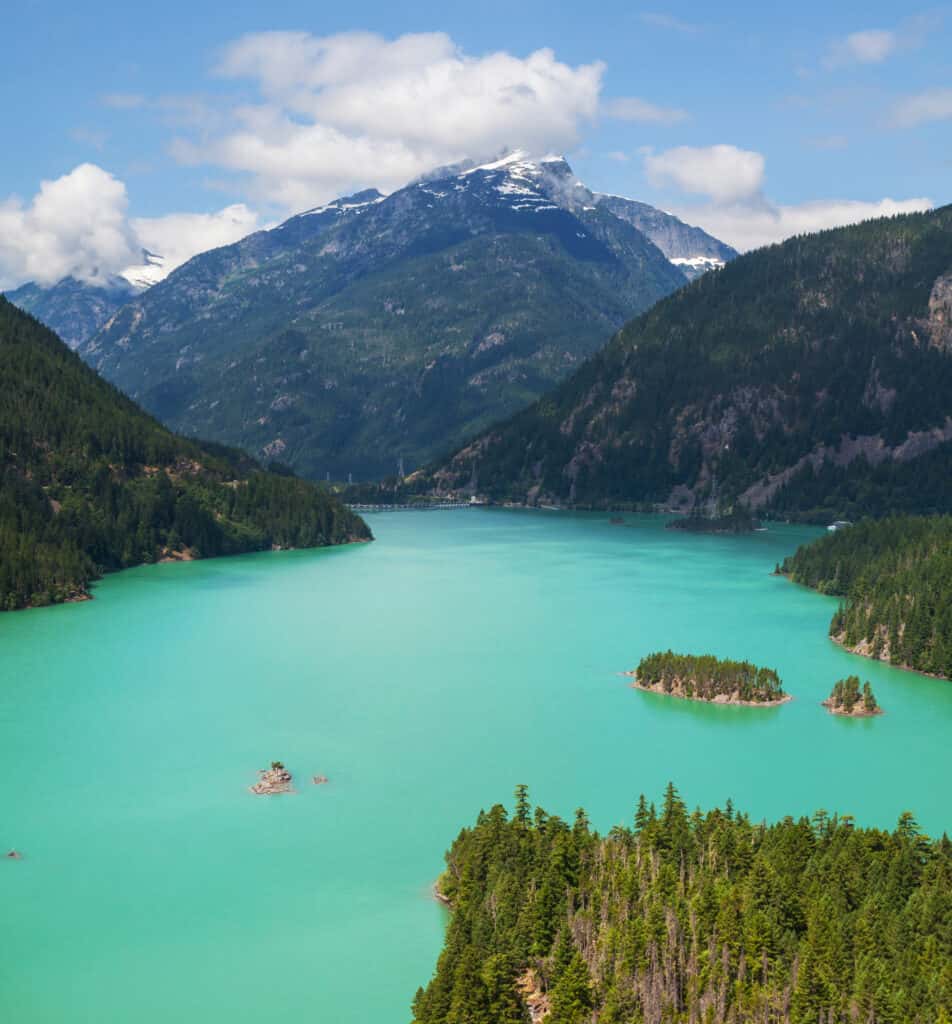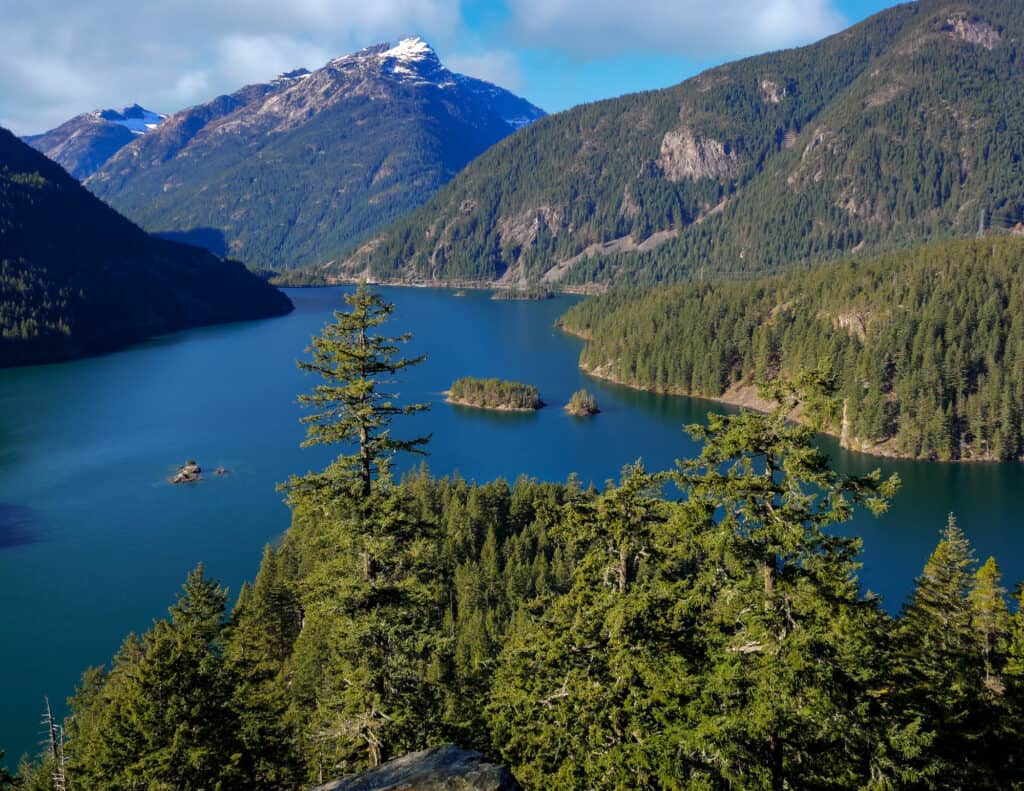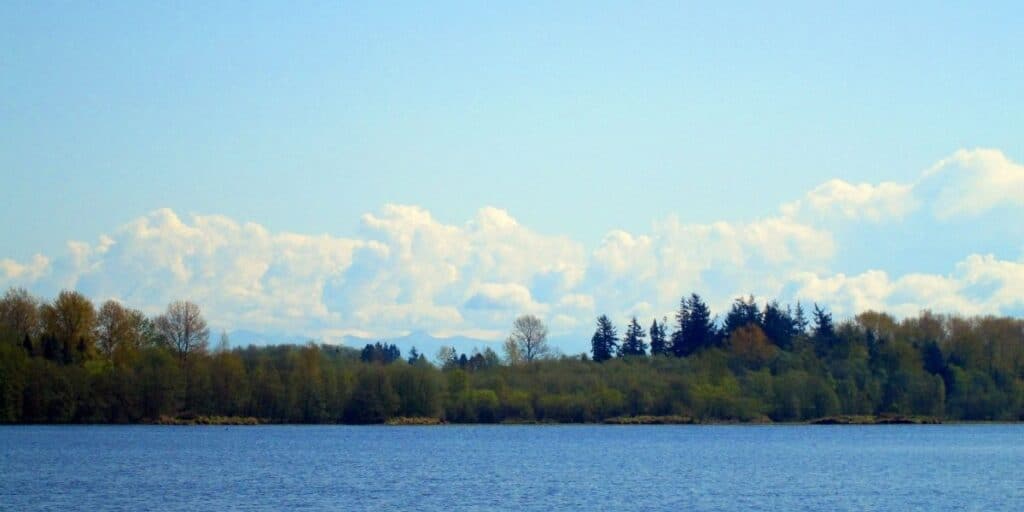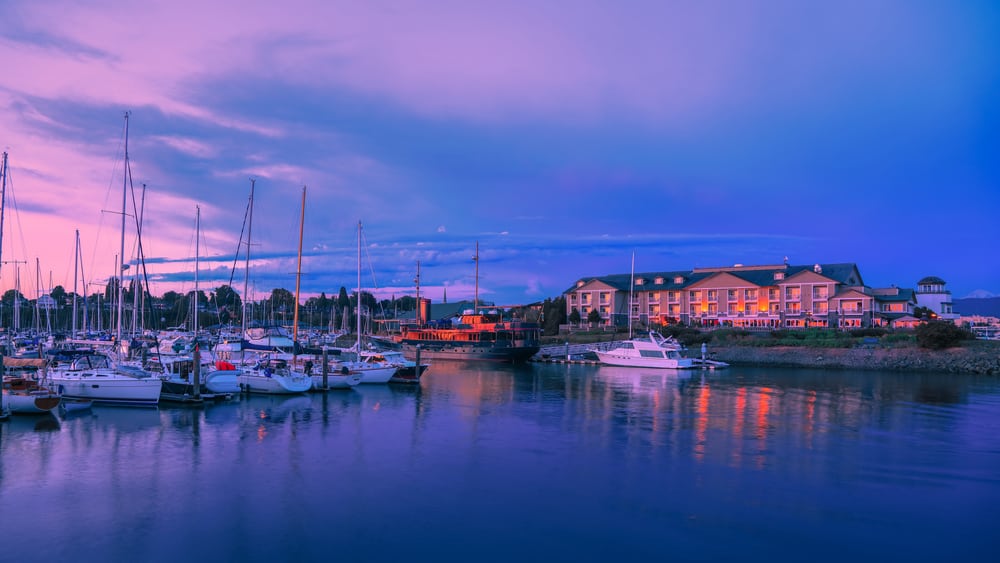Bellingham and Whatcom County sit in the northwest corner of Washington’s mainland, just below and Canada and hemmed between the saltwater of the Salish Sea and the towering mountains of the northern Cascades mountain range.
All of that water and wilderness comes with tons of great fishing across Whatcom County, which is rich with lakes filled with trout, kokanee and bass, as well as a few streams bearing modest numbers of salmon and steelhead.
The Salish Sea and Bellingham Bay offer their own opportunities to catch fish and shellfish.
Whatcom County has more than 200,000 residents who live in Bellingham, other cities including Blaine, Everson, Ferndale, Lynden, Nooksack and Sumas, and in smaller communities and rural areas.
The county also includes Mount Baker, North Lookout Mountain, Eliza and Portage Islands and part of the stunning North Cascades National Park. Western Washington University is in Bellingham.
Note that there are some state advisories that recommend anglers limit consumption of some species of fish caught in a handful of Whatcom County waters, including Lake Fazon, Lake Samish, Lake Whatcom and Ross Lake.
Check the the Washington Department of Health’s Fish Consumption Advisories page for details.
The main part of this article is a quick look at many of the best fishing holes in Whatcom County.
However, we’d also note that you can expect to find our “Fishing in Neighboring Counties” feature at the end of this article.
This feature quickly links you to all of the best fishing opportunities in the counties located on the northwestern side of Washington, many definitely worth a relatively short drive from Bellingham.
Baker Lake
This big seasonally open reservoir has become one of the better-known fishing spots in Whatcom County, thanks to a sockeye salmon run that can offer pretty good fishing some years even while other types of salmon runs aren’t looking so hot.
The sockeye season runs from July 15 through the end of August, but it’s probably still wise to check to make sure there aren’t any special regulations.
Check WDFW’s Baker River sockeye page for in-season information, as well seeing if the agency has imposed emergency rules affecting sockeye fishing.
In addition to the ocean-going sockeye that run up the Skagit River and turn into the Baker River on their way to a trap and truck ride to Baker Lake, the lake itself also is home to sockeye that decide to stay put in the lake, fish more commonly known as kokanee.
The kokanee fishing picks up in the spring after the opener and continues into early summer. There might be a summer lull but kokanee can be caught into the fall.
Note the special rules for kokanee and sockeye length requirements.
There are some rainbow trout here as well that you can keep, but they aren’t stocked so don’t expect easy trout limits.
Additionally, know your trout because there are bull trout living in the reservoir that are protected from fishing. Release them unharmed if you catch one incidentally while chasing other game fish.
Mountain whitefish are here as well.
More: Baker Lake Fishing
Baker River
This Skagit River tributary is closed to all fishing, so stick to the lakes and reservoirs in this area.
Cain Lake
This smallish seasonal lake southeast of Bellingham gets a very nice planting of about 9,000 rainbow trout for the late April opener.
Trout fishing will be best early in the open season and slow down as fish are caught and the water warms up, slowing down fishing for the survivors. Those smaller numbers of trout that do make it to fall are likely to be larger and back on the bite when the water cools again.
During those warm months, the better bet might be to try to catch the lake’s resident largemouth bass and yellow perch.
The lake, a little over 70 acres in size, is mostly surrounded by a community of private homes and docks, but you can access it via a boat launch and a little bit of shore fishing space at the WDFW site at the southwest end of the lake, right where Camp 2 Road, Alder Drive and Costanti Lane intersect.
It’ll take just over 20 minutes to drive there, taking the Alger Cain Lake exit east from Interstate 5.
Dakota Creek
This small Blaine-area seasonal fishing stream might produce some sea-run cutthroat in the late summer and early fall, then perhaps a few dozen coho salmon come October.
Wild Chinook must be released from October to the creek’s closure in December. Additionally, a few winter steelhead might run up before it closes, but wild steelies also must be released.
Diablo Lake

You shouldn’t have a devil of a time catching fish at Diablo Lake, which is stocked with more than 200,000 young rainbow trout per season.
These fish arrive in the fall and feed in the upper Skagit River reservoir’s 800-plus acres, reaching catchable size by the following season. They join a good number of naturally reproducing rainbows already in the reservoir.
Most anglers would agree that fish that eat natural foods are feistier and taste better than pellet-reared trout.
The mountain reservoir is also home to bull trout, but these are protected natives and you’ll need to let it go unharmed if you catch one incidentally.
The reservoir is legal to fish all year, but WDFW recommends checking the North Cascades National Park’s Boating and Fishing page to make sure access is available prior to your trip.
There is fairly good (but undeveloped) bank access, but a boat or other watercraft will get you to more fish on this big water, which runs deep.
The reservoir is on State Route 20 about seven miles past Newhalem and well over an hour’s drive from Sedro-Woolley and Mount Vernon.
More: Diablo Lake Fishing
Fazon, Lake
This small lake near Bellingham is stocked every fall with fingerling brown trout that grow to decent size by the following year.
While Lake Fazon is open to fishing all year, you can’t fish from any floating device from early October well into January during duck hunting season, when it’s best to find somewhere else to fish. (Read the regulations.)
Lake Fazon may also be stocked with rainbow trout some years as well as channel catfish, which are an excellent game and eating fish.
Resident fish you can catch include good numbers of bluegill, largemouth bass and bullhead catfish, as well as yellow perch and pumpkinseed sunfish.
Lake Fazon was one of the early lakes stocked with tiger muskies, but it has been removed from this program. (See: Best Tiger Muskie Fishing in Washington.)
There is a WDFW boat launch at the southwest end of the 32-acre lake, off East Hemmi Road, but bank access is poor.
Lake Fazon is slightly over a 20-minute drive northeast of Bellingham, using SR-542 and Everson-Goshen Road.
Gorge Lake
Gorge Lake is a medium-sized reservoir on the Skagit River just downstream from the larger Diablo Lake, and it has similar fishing.
Gorge Lake also is stocked with many thousands of small rainbow trout each fall, allowing the fish to grow on location to catchable sizes by the following season.
You also must release any protected bull trout you might catch at this reservoir, which is a bit over 200 acres in size and in a narrow gorge as its name suggests.
There is a boat launch and shore access.
There’s some additional information including a link to current reservoir levels on the National Park Service’s website.
Gorge Lake is located just a couple miles up SR-20 from the Newhalem community and more than an hour east of Mount Vernon.
Nooksack River
This north county river isn’t the salmon and steelhead producer it once was (where have we heard that before?), but it can produce pretty good summertime pink salmon fishing in odd years when the runs are decent.
You may also catch hatchery coho salmon in late September and especially October.
These days the winter steelhead catches are fair (or less), with a few hundred taken in December and January in recent harvest reports. The North Fork is often the best option because hatchery smolts are released in the Kendall Creek area west of Maple Falls.
The Nooksack and its forks have a fairly complex set of rules, especially to protect some of its salmon, so as with all such fisheries, read the regulations carefully and watch for updates.
There are both sea-run and resident trout present, with minimum length requirements in place. The forks can have fair trout fishing (mostly for fish too small to keep), but it’s probably wise to wait until fall after the milky glacial run-off clears.
Padden, Lake
This medium-sized lake in Bellingham is a nice place to spend the day fishing for a variety of species, including trout, kokanee and bass.
Lake Padden is very nicely stocked with trout, including about 20,000 keeper-sized rainbows usually planted for the late April opener.
The ‘bows are usually supplemented by another 10,000 young winter-planted cutthroat trout, which grow to catchable size at the 150-acre seasonal fishing lake.
Lake Padden also is one of several Whatcom County lakes stocked with young kokanee (landlocked sockeye salmon), which typically provide the most action from late spring through summer. At our most recent check, the state was planning to stock about 100,000 of this tasty little salmon.
Besides trout and kokanee, Padden has a residential population of largemouth bass to provide some more action, especially in warmer months.
The lake is the centerpiece of Lake Padden Park, on the south end of Bellingham tucked between I-5 and the main park entrance on Samish Way.
Amenities for anglers include plenty of bank access, including fishing piers. Boaters can launch boats without gas motors.
More: Lake Padden Fishing
Ross Lake

This giant of a reservoir that stretches clear into Canada is actually fairly lightly fished.
One reason is that unlike Diablo and Gorge reservoirs below this one isn’t stocked, so the fishing is focused on wild rainbows, which can be fair to good at times but not easy. You can keep one wild rainbow at least 16 inches.
Another reason is the boat access is more difficult here. You can trailer a boat to the north end by going through British Columbia (when open) or you can launch through Ross Lake Resort on the south end.
Also, the lake opens later than most on July 1 and can be fished through October.
There also is access to largely undeveloped shorelines, including trails, in several areas.
Protected bull trout (Dolly Varden) must be released unharmed, but you can keep a five-fish limit of Eastern brook trout of any size.
There are some camping areas and boat camping is an option.
The Washington part of the lake (the vast majority) is in the Ross Lake National Recreation Area.
If you’re interested more in getting away from it all and having lots of lake to yourself than easy limits of fish, and you don’t mind working a bit for it, Ross Lake is worth a look.
Saltwater
The bays around Bellingham and Blaine offer a variety of fishing and especially shellfishing for crabs, clams and oysters.
Surf smelt can be jigged or raked, depending on the season.
Several public fishing piers are available.
Ports offer boat access to salmon and other fishing in deeper water.
Samish, Lake
This large lake along I-5 is another of the Bellingham area’s kokanee fisheries, thanks to annual plants of these young lake salmon.
Lake Samish also is a place to catch both largemouth and smallmouth bass, yellow perch and coastal cutthroat trout, the latter of which have modest harvest limits. There are brown bullhead catfish as well.
Lake Samish has a little over 800 surface acres but not a lot of public shoreline access good for fishing, so this is primarily a boat fishery.
WDFW maintains a boat launch on the east side of the lake, along E. Lake Samish Drive (which runs along the interstate).
The lake is only about 15 minutes heading south from Bellingham on I-5 or about 20 minutes if you’re driving north from Mount Vernon.
More: Lake Samish Fishing
Silver Lake
One of Washington’s many Silver Lakes, this one on the road to Mount Baker is a great place to catch stocked hatchery trout, and lots of them.
WDFW’s plans to plant about 16,000 catchable rainbows a year here for the late April opener, and spring trout fishing will be excellent in this mid-sized lake.
In fact, trout fishing should hold up here into the summer a bit better than at many stocked lakes, thanks to cool waters and plenty of fish.
You might also catch some resident coastal cutthroat trout, though there won’t be as many of those as the rainbows.
Shoreline access is good at Whatcom County’s Silver Lake Park, and both the park and WDFW maintain boat launches on the lake, which is over 150 acres in size. The park is located on the south end and the state launch is at the north.
The park also offers boat rentals, tent camping and cabin rentals, so this is a good place to come and stay a few days.
The lake is a nice escape from the city, but under an hour’s drive from Bellingham. Take State Route 542 to Maple Falls and then Silver Lake Road five miles north to the lake.
Squalicum Lake
What to catch a different type of trout on a fly?
Squalicum Lake is a fly fishing-only lake near Bellingham that is planted with young tiger trout, an aggressive hybrid mix of brook and brown trout. (The fish are sterile.)
The lake also is planted with the more common catchable-sized rainbow trout each spring (around May) and has a resident population of coastal cutthroat trout.
You can keep two trout that are at least 14 inches, but many fly anglers practice catch and release.
At a little over 30 acres, Squalicum is a fairly small lake that is open all year and likely to fish best in the spring and should be decent when the water cools again in the fall.
You can’t bring a motor here, but you won’t want to anyway because it requires a little walk to reach the shore. A float tube or other portable, person-powered watercraft will improve your access, especially once aquatic plants fill in much of the shallow water along the shoreline.
Squalicum Lake is a 15-20 minute drive from Bellingham. Head northeast on SR-542 (Mt. Baker Highway) and the lake sits just a quarter mile south of the highway just before you get to the small community of Rome. There is a WDFW parking area.
Terrell, Lake

This good-sized lake west of Ferndale is fairly lightly stocked with rainbow trout for its size but also has coastal cutthroats and is one of the select lakes planted with channel catfish.
Lake Terrell also has resident populations of several other warmwater game fish, including largemouth bass, yellow perch, bluegill and brown bullhead catfish.
Additionally, the lake holds not one but two Washington state game fish records, including a massive channel catfish and a considerably smaller (but big for its species) pumpkinseed sunfish.
WDFW maintains a boat launch on the south end, off Lake Terrell Road, and that access also includes a fishing pier and a limited number of other bank fishing opportunities.
Weed growth can hamper bank fishing access as the season goes on.
Also be aware that Lake Terrell sits within a wildlife area that is open to waterfowl hunting.
While it’s open to fishing year-round, and you are not allowed to fish from any sort of boat or floating device (except a floating dock) during the shooting season, which is a fairly slow time for fishing this lake anyway. Check the regulations for dates impacting boat fishing.
The lake is located about five miles west of Ferndale heading out Mountain View Road. It’ll take you only about 25 minutes from Bellingham or Blaine.
Toad Lake
This small lake turns into a prince each spring, when plants of about 5,000 catchable rainbow trout make little Toad Lake a great trout fishing spot.
The roughly 30-acre lake near Bellingham is seasonal, opening in late April, and trout fishing will be at its best in the early weeks of the season but may perk up again in the fall before the lake closes after Oct. 31.
WDFW also notes a resident population of kokanee in the lake, which are likely to move into deeper waters during the summertime, when boaters who get down to them can do well.
There are some largemouth bass in Toad Lake as well, as these shallower water fish are likely to bite once the water warms up a bit by late spring through summer.
A WDFW access includes a boat launch and a small fishing pier. It’s located on the southwest side off Toad Lake Road, while private homes border a good part of the rest of the lake.
Toad Lake is a little over six miles northeast of Bellingham.
Whatcom Falls Derby Pond
This tiny pond on Whatcom Creek is located in Whatcom Falls Park in Bellingham and is regulated for young anglers.
The city park pond tends to be stocked with about 500 hatchery rainbow trout for the opener in late April.
Whatcom Creek
This small stream flowing out of Whatcom Lake has been primarily fished in November for a pretty good chum salmon run.
There is a hatchery program at Bellingham Technical College, where anglers may help collect chum salmon for the operation.
There are a few coho that might appear in the fall salmon catch as well.
There are some rainbow and cutthroat trout, but they must be 14 inches to harvest.
Whatcom, Lake
Whatcom County’s namesake giant lake is easily one of the best kokanee and smallmouth bass fishing destinations in northwestern Washington.
The approximately 5,000-acre Lake Whatcom also has largemouth bass and yellow perch for anglers to catch. Brown bullhead, pumpkinseed sunfish and peamouth may also bite your hook. Some sources have reported mackinaw (lake trout).
Like most area lakes, Lake Whatcom also has native coastal cutthroat trout, but fishing for this species is closed here due to a population crash attributed to logging and urban development affecting their spawning tributaries, according to WDFW.
Fishing in tributaries and an area near the dam also are off limits to fishing, so definitely check this year’s regulations for current rules.
No matter, Lake Whatcom is chock full of kokanee, thanks to plants of young fish typically numbering in the 4 million range.
The lake also is a favorite among bassers, thanks to ample numbers of smallmouth bass and a smaller population of potentially larger largemouths.
Many anglers head to Bloedel Donovan Park, where the city of Bellingham provides a nice boat launch and some bank fishing access. You can also rent small boats such as kayaks and canoes.
On the other end of South Lake Whatcom Boulevard, WDFW has a small gravel boat launch on South Bay Drive next to the fire station.
More: Lake Whatcom Fishing
Wiser Lake
This 100-plus acre lake near Lynden is primarily managed as a warmwater fishing spot, with catches of largemouth bass, brown bullhead catfish and pumpkinseed sunfish likely catches if you fish here, especially in the late spring and early summer.
There may also be some perch, crappie and the occasional trout, according to some sources.
SR-539 crosses the lake and provides access to a WDFW boat launch on the north side in the community of Wiser.
The lake is about 20 minutes north of Bellingham.
Fishing in Neighboring Counties
Okanogan County: To the east, the state’s largest county is loaded with lakes filled with trout, kokanee and other gamefish.
Skagit County: To the south, the Skagit River and streams, lakes and saltwater with salmon, trout, shellfish and plenty more to catch.
San Juan County: To the southwest, the San Juan Islands have lots of access to saltwater salmon, crabs, shrimp and more, plus some surprising trout lakes.
Washington Resources
WDFW Fishing and Stocking Reports
WDFW Fishing Regulations
National Weather Service forecasts

